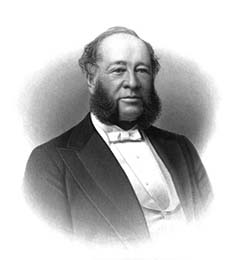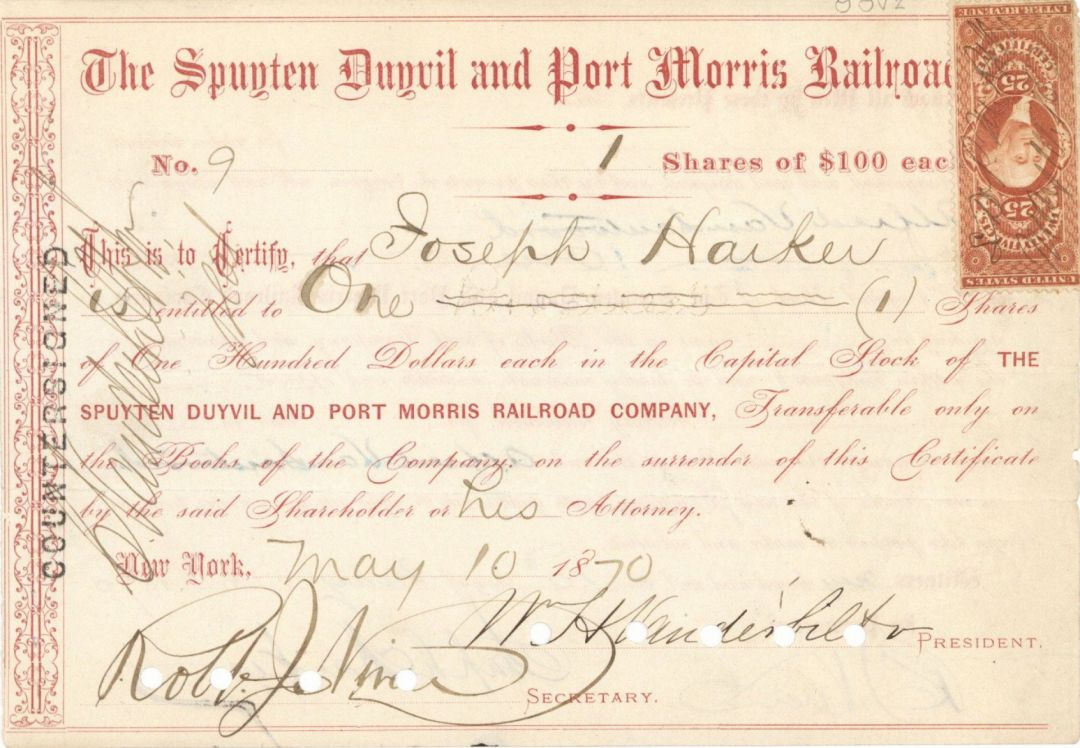Spuyten Duyvil and Port Morris Railroad Co. signed by W.H. Vanderbilt and Cornelius Vanderbilt Jr. - Stock Certificate
Inv# AG2616 StockStock signed by Cornelius Vanderbilt Jr. on the left front of stock and W.H. Vanderbilt as president. 25 cents revenue stamp on front.

Cornelius Vanderbilt II (1843-1899) Noted Financier and Head of the House of Vanderbilt in the third generation. He was the favorite grandson of Cornelius Vanderbilt, who left him $5 million, and the eldest son of William Henry Vanderbilt, who left him close to $70 million. In his turn he succeeded them as head of the New York Central and related railroad lines in 1885. He had a reputation as something of a workaholic, though a stroke in 1896 compelled him to reduce his active business involvement. Though retired from active control he took an advisory role in the many properties in which he, and the family, had made investments. Regarded as a capable and conservative railroad manager, and a splendid accountant; mastering the intricacies of the banking system during his association with the Shoe and Leather Bank of New York. Between 1885 and his untimely death in 1899 the stock of the leading railroads, with which the Vanderbilt name was then identified, had enhanced in value to the amount of $173,497,000. over their worth at the time he assumed control. Kindly, charitable, and democratic, he held the respect of employees at all levels of the Vanderbilt railroad interests. This Cornelius, deriving no pleasure in yachting, or the Turf, sought the satisfactions of philanthropy, fine music, good paintings and exquisite architecture. He married Alice Claypoole Gwynne (1852-1934). Their eldest son William Henry Vanderbilt II (1870-1892) died while a junior at Yale University, and Cornelius endowed a large dormitory there. He disinherited his second son Cornelius Vanderbilt III (1873-1942) for marrying without his approval. Third son Alfred Gwynne Vanderbilt (1877-1915) went down with the RMS Lusitania. His remaining son was Reginald Claypoole Vanderbilt. His daughters were Gertrude Vanderbilt Whitney and Countess Gladys Vanderbilt Széchenyi. The fabulous Fifth Avenue mansions he, his brothers, and his sons lived in have been demolished, but the Newport, Rhode Island vacation home he built, The Breakers, still stands as a memory of the lifestyle of Cornelius Vanderbilt II. On his death, family leadership passed to his brother, William Kissam Vanderbilt. His philanthropy had been such that he did not increase the wealth that had been left to him.

William Henry Vanderbilt (1821-1885) A businessman and a member of the prominent United States Vanderbilt family.
He inherited nearly $100 million from his father Cornelius Vanderbilt and had increased it to about $200 million at his death less than nine years later. At the time, he was the richest man America had ever seen, however his worth was pale in comparison to the likes of John D. Rockefeller and Andrew Carnegie.
His father carefully oversaw his business training, at age 18 starting him out as a clerk in a New York banking house. After joining the executive of the Staten Island railway, he was made its president in 1862 then three years later he was appointed vice-president of the Hudson River railway. In 1869, he was made vice-president of the New York Central and Hudson River Railroad Company, becoming its president in 1877. As well, he took over from his father as president of New York Central Railroad, the Lake Shore and Michigan Southern Railway, the Canada Southern Railway, and the Michigan Central Railroad.
He had worked with his father and following his death, actively expanded the family's railroad empire. In 1883, his elder sons assumed key positions. It was in his time that the Vanderbilt women demanded recognition from the older but less moneyed leaders of New York City society, centered on the Astor family, whom the Vanderbilts had by then far outstripped in wealth.
William Henry Vanderbilt was involved in a number of philanthropic causes including the YMCA, funding to help establish the Metropolitan Opera and an endowment for the College of Physicians and Surgeons at Columbia University. In 1880, he provided the money for Vanderbilt University to construct the Wesley Hall building for use as the Biblical Department and library and included 160 dormitory rooms for students and professors, lecture halls, as well as a cafeteria. The building was destroyed by fire in 1932 and his son Frederick made another donation to help cover the insurance shortfall and allow a new building to be erected.
An art enthusiast, William Henry Vanderbilt's collection included some of the most valuable works of the Old Masters and over his lifetime, Vanderbilt acquired more than 200 paintings.
Among his holdings were:
Chicago, Burlington and Quincy Railroad, Chicago and Canada Southern Railway,
Detroit and Bay City Railroad, Hudson River Railroad, Hudson River Bridge, Joliet and Northern Indiana Railroad, Michigan Midland and Canada Railroad, New York Central and Hudson River Railroad, New York Central Sleeping Car Company, New York and Harlem Rail Road, Spuyten Duyvil and Port Morris Railroad, Staten Island Rail-Road. In 1883, he resigned all his company presidencies and had his sons appointed as chairmen but left the day-to-day running of the businesses to experienced men appointed president.
William Henry Vanderbilt is perhaps most remembered for snapping "the public be damned" at an interviewer..in context, an irritated reaction to the other's suggestion that the New York Central Railroad system, which Vanderbilt controlled, ought to be operated as if it were a public trust.
A stock certificate is issued by businesses, usually companies. A stock is part of the permanent finance of a business. Normally, they are never repaid, and the investor can recover his/her money only by selling to another investor. Most stocks, or also called shares, earn dividends, at the business's discretion, depending on how well it has traded. A stockholder or shareholder is a part-owner of the business that issued the stock certificates.










Ebay ID: labarre_galleries